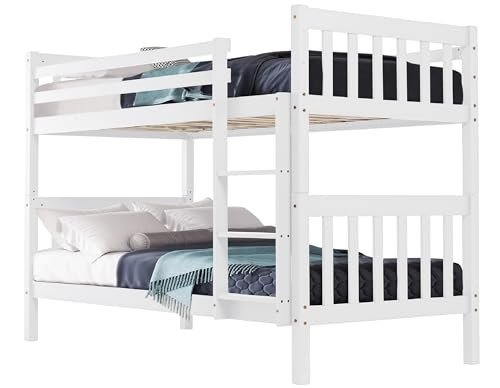A Comprehensive Guide to Children's Bunk Beds: Styles, Benefits, and Safety Considerations
Bunk beds have ended up being a popular choice for households wanting to take full advantage of space and provide a fun sleeping environment for kids. With www.bunkbedsstore.top , they offer a creative and useful service for shared bedrooms, playrooms, or perhaps guest lodging. This post checks out the various designs of children's bunk beds, their advantages, security considerations, and responds to some frequently asked concerns.
The Allure of Bunk Beds
Children's bunk beds are more than simply space-saving structures; they are likewise a gateway to adventurous dreams and creative play. Below is a comprehensive assessment of their numerous advantages.
Advantages of Bunk Beds
- Space-Saving: Bunk beds effectively utilize vertical space, making them an ideal option for smaller sized spaces.
- Lively Design: Many bunk bed designs consist of slides, tents, and themed elements, sparking imagination and enjoyment.
- Partner Sharing: Bunk beds are best for brother or sisters sharing a room or accommodating pajama parties.
- Versatile Use: Some models can be separated into 2 individual beds, providing flexibility as kids grow.
- Storage Options: Many bunk beds include integrated drawer storage or shelves, even more enhancing their practicality.
Styles of Children's Bunk Beds
The variety of bunk beds available today accommodates various preferences and needs. Below is an overview of some popular designs.
| Design | Description | Best For |
|---|---|---|
| Standard Bunk Bed | A conventional design featuring one bed stacked above another. | Brother or sisters sharing a space. |
| Loft Bed | Comparable to a bunk bed without the bottom bunk, enables a work space or play location listed below. | Minimal space for play/desk. |
| L-Shaped Bunk Bed | Two beds set up in an L-shape, often with additional sections for storage or play. | Special room designs. |
| Twin Over Full | A twin bed over a full bed, accommodating various sleep requirements. | Growing kids and teens. |
| High Sleeper | Stands even greater than a loft bed, usually featuring a desk or play location listed below. | Older kids needing more play/desk space. |
| Tent Bunk Bed | Bunk beds with a canopy or tent-like structure, developing a cozy, enjoyable space. | Active and imaginative kids. |
Key Features to Consider
When choosing the best bunk bed for children, the following features deserve considering:
- Material: Bunk beds can be made from wood, metal, or a combination. Each has its distinct aesthetic and durability.
- Weight Capacity: Always confirm the weight limit of the bunk bed to guarantee it can accommodate your children securely.
- Safety Rails: Ensure the top bunk has strong rails to prevent falls.
- Ladder Security: A well-designed ladder needs to provide simple and safe access to the upper bunk.
- Finishing: Ensure any surfaces are non-toxic and safe for children.
Safety Considerations
Safety is critical when it concerns kids's bunk beds. The following standards ought to be complied with:
- Age Appropriateness: Generally, kids under 6 years old ought to not oversleep the upper bunk due to security threats.
- Tough Construction: Ensure the frame and materials are strong and can support the weight without drooping.
- Routine Maintenance: Periodically look for loose screws, bolts, or other parts that might require tightening.
- Clear Play Area: Keep the location around the bunk bed without toys and obstacles to lessen tripping risks.
Setting Rules for Safe Use
Establishing guidelines for bunk bed use will help guarantee security:
- Limit Jumping and Climbing: Children ought to be advised versus jumping from the leading bunk and getting on the sides.
- Monitoring Sleepovers: Monitor young visitors while they are utilizing the bunk bed for the very first time.
- Educate on Ladder Use: Teach how to use the ladder safely, stressing the importance of dealing with the ladder when climbing or down.
Frequently Asked Questions
1. What age is suitable for a kid to sleep in the top bunk?
Many makers suggest that children must be at least six years old to sleep in the upper bunk. This standard is developed to mitigate the threat of falls.
2. Can bunk beds be customized?
Yes, lots of manufacturers use customizable options, including colors, materials, and additional functions like drawers or desks.
3. Are bunk beds safe for weight?
Bunk beds have weight limitations, usually varying from 200 to 400 pounds, depending upon the design and material. Constantly examine the maker's specifications.
4. How do I maintain and clean up a bunk bed?
Regularly inspect for loose parts, keep the bed clean by cleaning down surfaces, and make sure the bed linen is fresh to promote a safe and hygienic sleep environment.
5. Can bunk beds be separated into private beds?
Many bunk beds come with an option to separate them into two specific beds, supplying long-lasting flexibility.
Children's bunk beds are more than mere furnishings; they are a practical, flexible, and creative component of a kid's space. With different designs readily available and various safety factors to consider to bear in mind, parents can select the best bed that fits their space, satisfies their kids's needs, and instills a sense of adventure. By comprehending the advantages, styles, and safety measures associated with bunk beds, families can create a wonderful and safe sleeping environment for their children. Whether for brother or sisters sharing a room or space-saving services, bunk beds remain a precious option for lots of homes.

